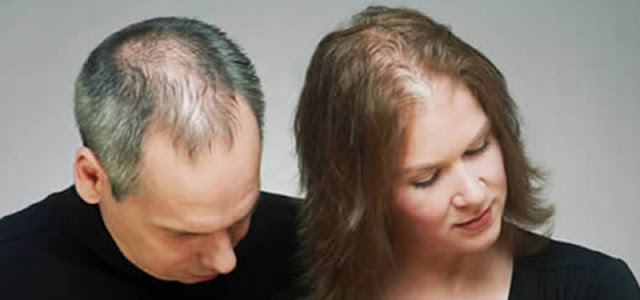What is hair loss?
There are a number of causes of baldness, but there are a handful of hair loss types that are particularly common in men and women. Some hair loss types are temporary, but other types are longer lasting, and therefore much harder to treat.
Hair loss, also called alopecia, is a disorder caused by an interruption in the body’s cycle of hair production. Hair loss can occur anywhere on the body, but most commonly affects the scalp. It is normal to lose between 50-150 hairs a day, because we are constantly generating new strand growth. However, baldness occurs when the body has stopped generating new hair growth.
Hair loss, also called alopecia, is a disorder caused by an interruption in the body’s cycle of hair production. Hair loss can occur anywhere on the body, but most commonly affects the scalp. It is normal to lose between 50-150 hairs a day, because we are constantly generating new strand growth. However, baldness occurs when the body has stopped generating new hair growth.
A hair growth cycle consists of three phases; the Anagen phase, the catagen phase, and the telogen phase. The anagen phase can last for many years, but during the catagen phase, the hair stops growing and separates from its follicle, and lasts about 10 days. During the telogen phase, the follicle rests for two to three months, before the hair falls out. The next anagen phase begins as a new hair grows in the same follicle.
Hair loss is usually linked to a person’s genetics, although many medical and behavioural conditions may interrupt the growth cycle and cause hair loss. Some temporary forms of hair loss are caused by daily routines such as over-brushing, which can lead to breakage and damage of the strands.
Types of Hair Loss
To simplify the different types of hair loss, we refer to them in a way in which you can relate to. Of the many types of baldness, these are the main types of hair loss in adults, simplified:
Androgenetic Alopecia (Permanent)
There is no cure for pattern baldness, however, it can be managed and treated to a certain extent. Whilst hair regrowth isn't usually possible, there is a chance of slowing down, and even stopping the issue, if tackled early enough.
Postpartum Hair Loss
Postpartum baldness can occur in women shortly after they have given birth. Many new mums see noticeable hair shedding within just a few months of having a baby.
This is normal — and generally seen as a temporary form of hair loss, however, in some cases, postpartum hair loss can lead to longer terms of baldness, with some women never fully recover from it. Dermatologists refer to this condition as excessive hair shedding. The excessive shedding is caused by falling estrogen levels.
Again, much like postpartum hair loss, menopausal hair loss is generally known to be a temporary form of hair loss. It occurs shortly after women enter menopause, but only lasts from a few months, up to a year. However, menopausal shedding can last for longer periods, even years, so it depends on each individual.
Menopausal Hair Loss
Again, much like postpartum hair loss, menopausal hair loss is generally known to be a temporary form of hair loss. It occurs shortly after women enter menopause, but only lasts from a few months, up to a year. However, menopausal shedding can last for longer periods, even years, so it depends on each individual.
Seasonal Hair Loss
Seasonal hair loss is something that can occur in many men and women during certain parts of the year. The most common seasons when people shed hair are spring and autumn, however, some people shed excessively during winter and summer.
Seasonal hair loss is usually temporary, however, it can keep reoccurring twice a year, which is not ideal for people who have weak hair, or are already prone to hair loss.
Stress Related Hair Loss
Many factors, including stress, can play a significant role in hair loss. Many men and women suffer from excessive hair shedding during a time in their life when they are stressed, depressed, or are going through a traumatic experience. The rate of shedding usually slows or stops when the stressful period is over, but it can continue for some people.
Self-Inflicted Hair Loss
In some cases, hair loss can be self-inflicted, so, for example, constant pulling of the hair (traction alopecia), poor hair care management, and use of harsh, chemically induced products.
This is obviously something that can be stopped, but ongoing self-inflicted damage to the hair can cause long term problems.
Treatments for Hair Loss
There are quite a few options available for treating baldness and thinning hair. The market is saturated, and most products have no success in treating the hair, however, there are some good treatments on the market that can help slow down and even stop excess hair shedding in both men and women.
Medically Approved Treatments
There are only two medically approved treatments for hair loss. The first is finasteride, which is an oral pill for male pattern baldness. The second is minoxidil, which is a topical solution for men and women.
Both can give promising results, however, both can also give you negative side-effects, particularly finasteride. Common side-effects from using finasteride include; erectile dysfunction, low libido, impotence, skin rash, feminisation, depression, headaches, and fatigue.
Both treatments can be effective, however, many men and women are not willing to compromise on their health, and therefore seek safer alternatives.
Hair Surgery
Surgical procedures such as hair transplants and scalp micropigmentation, offer patients a viable solution for hair loss, but they come at an expensive price. Surgical treatments can range from £3000-£10,000+, depending on what needs to be done. It is more than likely that more than one surgical treatment will be needed, so it is an ongoing treatment.
It's a risk, but it can pay off if it goes well. We expect the continued development of hair surgical procedures to make transplants even more affordable and accessible in the coming years.
Keratinocyte growth factor is an important endogenous mediator of hair follicle growth, development, and differentiation. When used regularly, KGF can help with the prevention of hair loss, and promotion of function of healthy hair growth, in both men and women.
Micro needling involves the use of a derma roller (or derma stamp) which contains small needles that causes minor skin injuries. While used as an anti-aging skin treatment, micro needling may also be a method of treatment for hair loss. There's even evidence that it can help a special type of hair loss known as alopecia areata.
You may have heard that laser combs, brushes, hoods, and caps can help halt hair loss. The theory is that when hair follicles absorb laser light at a certain level, it stimulates hair to grow. But there's not enough evidence that any of these devices restore hair or prevent balding.
Ketoconazole is an antifungal drug used to manage scalp conditions like dandruff. But ketoconazole is also used as a hair loss treatment for androgenetic alopecia (genetic pattern baldness) in both men and women. Although its not medically approved, Nizoral shampoo, which contains ketoconazole, has shown to help treat hair loss when used in conjunction with other treatments.
Hair Growth Supplements
Multi-vitamin hair growth supplements like HR23+ are safe alternatives to the harsh prescription drugs like finasteride. Many men and women are experiencing excellent improvements in their hair from using multi-vitamin supplements.
Multi-vitamin supplements can help slow down hair fall, support healthy hair growth, and increase the thickness of the strands. These types of supplements are becoming the most popular treatment for hair loss.
Keratinocyte Growth Factor (KGF)
Keratinocyte growth factor is an important endogenous mediator of hair follicle growth, development, and differentiation. When used regularly, KGF can help with the prevention of hair loss, and promotion of function of healthy hair growth, in both men and women.
The most common, and recommended form of KGF, is to use it as a serum. Applying KGF to the scalp, just 3-4 times a week, can help combat hair loss, with no major side-effects.
Micro Needling
Micro needling involves the use of a derma roller (or derma stamp) which contains small needles that causes minor skin injuries. While used as an anti-aging skin treatment, micro needling may also be a method of treatment for hair loss. There's even evidence that it can help a special type of hair loss known as alopecia areata.
Hair laser treatment
Ketoconazole Shampoo
What is the most Effective Hair Loss Treatment?
It is difficult to define what treatment is the most effective for hair loss. This is because most treatments have varying effects on different patients. Results will always vary from person to person.
It is also rare that one particular treatment would work effectively on its own. The most successful way to treat hair loss would be through multi-treatments, which is often referred to as a 'treatment plan'.
Treating hair loss isn't easy, and in most cases, it can take a period of trial and error to establish what treatments work for you, and which ones work best in conjunction with each other.
You may also be interested in the article: The Best Hair Loss Prevention Routine












Post a Comment